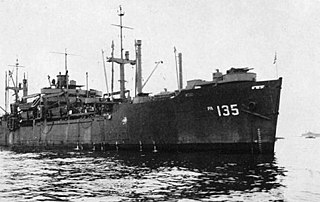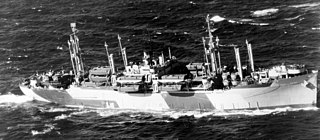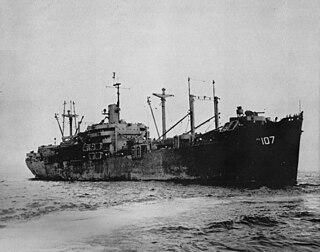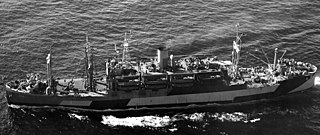
USS Venango (AKA-82) was a Tolland-class attack cargo ship in service with the United States Navy from 1945 to 1946. She was sold into commercial service and was scrapped in 1971.

USS Arenac (APA-128) was a Haskell-class attack transport in service with the United States Navy from 1945 to 1946. She was scrapped in 1974.

USS Bosque (APA-135) was a Haskell-class attack transport in service with the United States Navy from 1944 to 1946. She was scrapped in 1973.

USS Grafton (APA-109) was a Bayfield-class attack transport which served with the United States Navy from 1945 to 1946. She was sold into commercial service in 1947 and was scrapped in 1975.

USS Guilford (APA-112) was a Bayfield-class attack transport in service with the United States Navy from 1945 to 1946. She was sold into commercial service in 1947 and was scrapped in 1976.

USS Lander (APA/LPA-178) was a Haskell-class attack transport in service with the United States Navy from 1944 to 1946. She was sold for scrapping in 1983.

USS Bowie (APA-137) was a Haskell-class attack transport in service with the United States Navy from 1944 to 1946. She was scrapped in 1973.

USS Lowndes (APA/LPA-154) was a Haskell-class attack transport in service with the United States Navy from 1944 to 1946. She was scrapped in 1983.

USS Karnes (APA-175) was a Haskell-class attack transport acquired by the U.S. Navy during World War II for the task of transporting troops to and from combat areas.

USS Lubbock (APA-197) was a Haskell-class attack transport in service with the United States Navy from 1944 to 1946. She was scrapped in 1975.

USS Clay (APA-39) was a Bayfield class attack transport in service with the United States Navy from 1943 to 1946. She was then sold into commercial service and was scrapped in 1974.

USS Alpine (APA-92) was a Bayfield-class attack transport in service with the United States Navy from 1943 to 1946.She was sold into commercial service in 1947 and was scrapped in 1971.

USS Barnstable (APA-93) was a Bayfield-class attack transport in service with the United States Navy from 1944 to 1946. She was sold to commercial service in 1948 and finally scrapped in 1974.

USS Cecil (APA-96) was a Bayfield class attack transport that served with the United States Navy from 1944 to 1946. She was sold into commercial service in 1947 and was scrapped in 1973.

USS Goodhue (APA-107) was a Bayfield-class attack transport in service with the United States Navy from 1944 to 1946. She was sold into commercial service in 1947 and was scrapped in 1982.

USS Hansford (APA-106) was a Bayfield-class attack transport that served with the US Navy during World War II.

USS Mendocino (APA-100) was a Bayfield-class attack transport that served in the United States Navy from 1944 to 1946. In 1947, she was sold into commercial service and was scrapped in 1973.

USS Leon (APA-48) was a Bayfield-class attack transport in service with the United States Navy from 1944 to 1946. She was sold into commercial service in 1947 and was scrapped in 1971.

USS Baxter (APA-94) was a Sumter-class attack transport in service with the United States Navy from 1944 to 1946. She was subsequently sold into merchant service and was finally scrapped in 1968.

USS J. Franklin Bell (APA-16) was a Harris-class attack transport ship. She was built in 1921 and spent 20 years in merchant service as a passenger and cargo liner. She was acquired for the United States Army in 1940 and transferred to the United States Navy shortly after the USA entered the Second World War. She served throughout and after the Pacific War, was decommissioned in 1946 and scrapped in 1948.




















